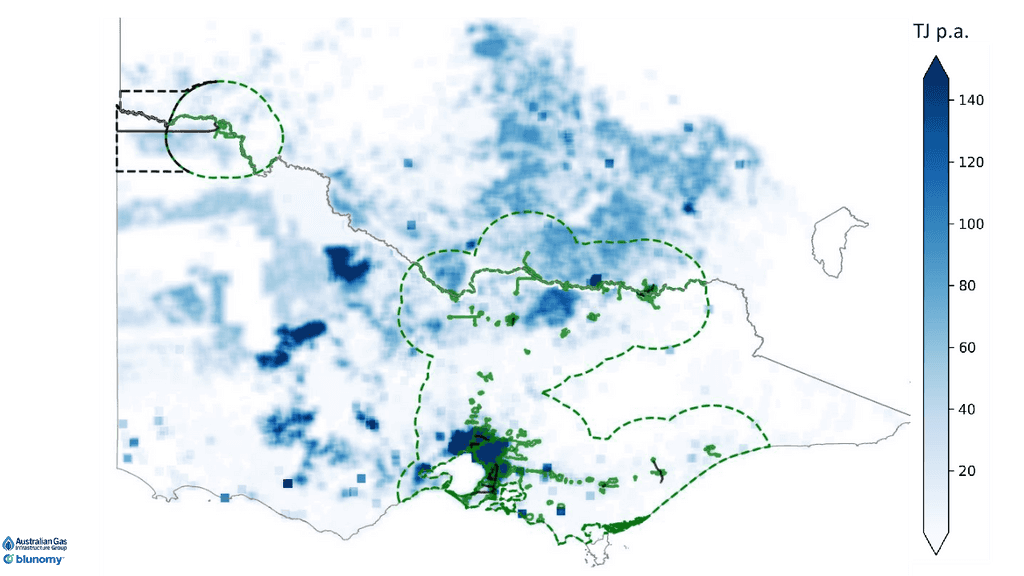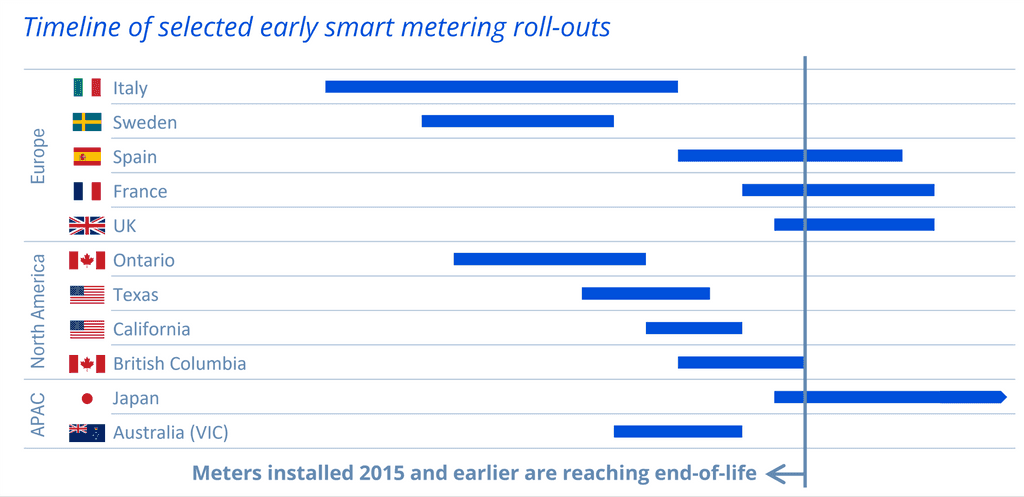Blunomy brief: July 2025
Giving biomethane a ‘fair go’ in Australia

Feedstock availability mapping across Victoria and southern New South Wales, showing transmission and distribution network catchment areas in dotted black and green lines respectively. (Source: Blunomy analysis)
The Clean Energy Regulator’s June 2025 amendments to Australia’s National Greenhouse and Energy Reporting rules now assign biomethane its own ‘Renewable fuels’ category - enabling network operators to claim Scope 1 emissions reductions via certified renewable gas guarantees . That makes it the perfect moment to revisit Blunomy’s in-depth mapping of biogenic feedstocks around major gas networks, which quantified both the volume of recoverable biomethane and its broader economic and environmental benefits:
- Supply unlocked: Under a policy-enabled scenario, biomethane potential within a 50 km radius of existing pipelines jumps from 44.4 PJ to 88.3 PJ per year—showing how clear reporting rules can translate directly into doubled feedstock mobilisation.
- Waste diverted & jobs created: Harnessing that resource could divert ~1.8 million tonnes of organic waste from landfill annually and support roughly 4,100 direct jobs across energy, water and waste sectors within the network regions.
- Competitive decarbonisation: Levelised cost of biomethane from landfill gas and wastewater streams sits at A$9.4–10.2 /GJ—on par with current wholesale gas prices—underscoring its viability as a cost-effective decarbonisation pathway for existing networks.
Transition infrastructure: What happens when the world’s first wave of smart meters reaches end of life?

Illustrative mapping of the timeline of early smart meter roll-outs. (Source: Blunomy analysis)
One of the very important, but perhaps under-appreciated, enablers of the transision is the humble smart meter. Early units are now coming to the end of their design life, and Blunomy recently benchmarked international smart meter replacement strategies across 8 major utilities and 3 OEMs, focusing on jurisdictions with meters now nearing or beyond their 15-year design life
- Failure rates rise steeply after year 12: Across multiple operators, meter failure rates more than doubled between 10–14 years of age, driven by issues in functional components, not metrology
- Replacement is often driven by more than failure: New features like 15-minute data, power quality, or edge intelligence are reshaping the business case in both Europe and North America.
- Regulatory justifications vary widely: EU countries often require minimal economic analysis for compliant upgrades, while North American regulators expect detailed cost-benefit cases grounded in asset condition and forward-looking functionality
Green pulse
Recent deals and market developments that have caught our eye.
⚡C&I distributed energy resources | Australian retail giant Wesfarmers agrees government-backed finance for solar and batteries: The Clean Energy Finance Corporation, an Australian government-backed lender, has agreed a AUD 100M loan for installation of rooftop solar, batteries, and EV charging across Wesfarmers’s Bunnings and Officeworks stores.
- C&I solar-plus-storage has historically been a niche (under 2 % of Australia’s installed PV) but is set for a growth spurt as falling battery costs and turnkey EPC/financing offerings finally make it attractive for large, roof-rich retailers.
- On-site generation and storage can not only offer an attractive means of decarbonising electricity consumption, but may also offer practical benefits for EV charger installation, potentially reducing the need to seek - and pay for - expanded grid connection capacity
🟢 Biomethane | EQT and Waga enter exclusive negotiations: Biomethane producer Waga entered exclusive negotiations with EQT on an acquisition deal.
- Unlike the dominant archetype for biomethane production in France, Waga specialises in valorising landfill gas through biomethane upgrading. This deal is a clear demonstration that this model can be attractive at scale.
🌱 Sustainable Aviation Fuel | US SAF project secures debt financing: Infinium’s Texas-based Roadrunner SAF production project has secured debt financing with HSBC.
- This marks a sector maturity milestone: attracting debt financing has to date been challenging for SAF projects, with projects not typically matching well with banks’ risk profiles.
- The Roadrunner project’s long-term revenues are derisked by offtake agreements signed with several airline groups including IAG and American Airlines.
🔋BESS | Recycled EV batteries find a new lease of life in Rome: Enel’s PIONEER project at Rome’s airport was officially inaugurated in June, reusing batteries from Mercedes-Benz, Stellantis, and Nissan EVs to form a 2.5 MW / 10MWh battery.
- As the first generations of EVs - and for that matter, BESS - reach the end of their design life there is a growing opportunity for circular solutions to deal with degraded batteries.
Blunomy news
- Blunomy co-hosted a well-attended panel discussion on nature-based solutions with hummingbirds. Moderated by hummingbirds CEO Anaïs BACH and Blunomy CEO Sebastien Guillo, panellists Marine de Bazelaire, Arthur Pasquier and Yann-Gaël RIO shared their views on the evolution of the carbon credit market, insetting and offsetting approaches, as well as best practices to deploy nature-based solutions at the heart of the value chain.Stay tuned for similar events!
- The Vision team enjoyed a visit to Geneva for CIRED 2025, where planning and forecasting were really the flavour of the moment. The functionalities that Vision brings to distribution networks will be instrumental in addressing many of the challenges the sector is facing.
- Planning is well underway for the annual ALLICE congress in September, and Blunomy is proud to sponsor the event. We’re looking forward to talking all things decarbonisation and catching up with partners across a wide range of industries.
- Blunomy refreshed our website this month. If you’ve not visited recently, take a look at our new design!